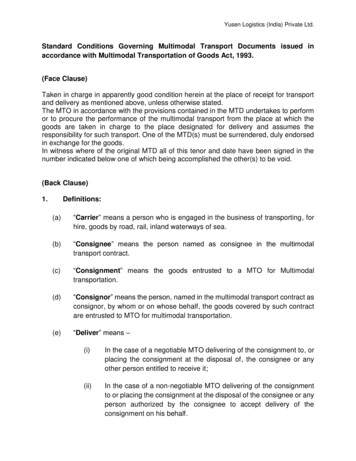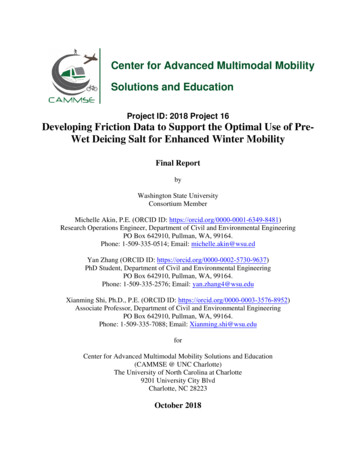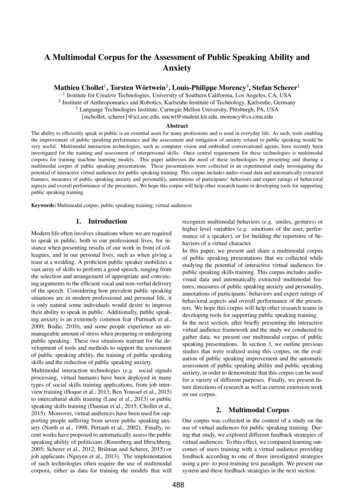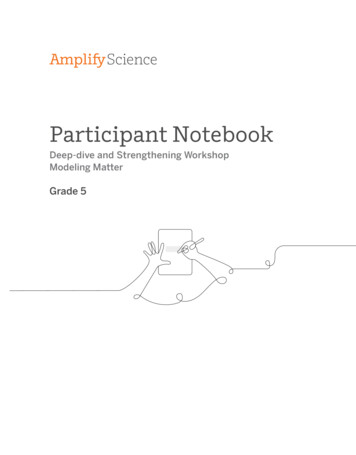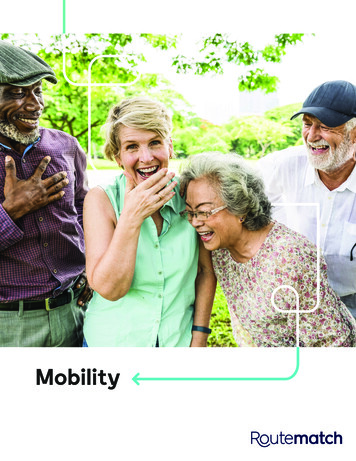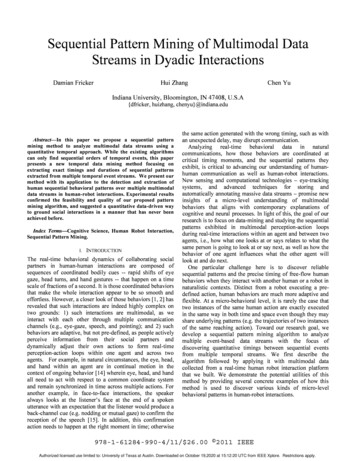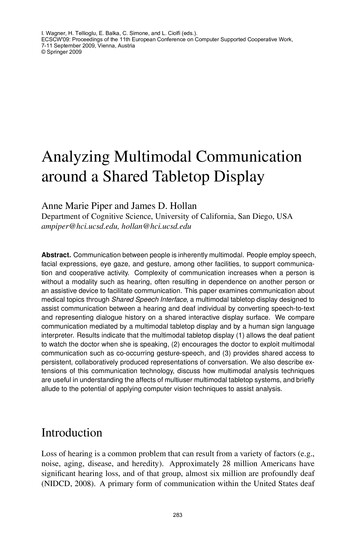
Transcription
I. Wagner, H. Tellioglu, E. Balka, C. Simone, and L. Ciolfi (eds.).ECSCW'09: Proceedings of the 11th European Conference on Computer Supported Cooperative Work,7-11 September 2009, Vienna, Austria Springer 2009Analyzing Multimodal Communicationaround a Shared Tabletop DisplayAnne Marie Piper and James D. HollanDepartment of Cognitive Science, University of California, San Diego, USAampiper@hci.ucsd.edu, hollan@hci.ucsd.eduAbstract. Communication between people is inherently multimodal. People employ speech,facial expressions, eye gaze, and gesture, among other facilities, to support communication and cooperative activity. Complexity of communication increases when a person iswithout a modality such as hearing, often resulting in dependence on another person oran assistive device to facilitate communication. This paper examines communication aboutmedical topics through Shared Speech Interface, a multimodal tabletop display designed toassist communication between a hearing and deaf individual by converting speech-to-textand representing dialogue history on a shared interactive display surface. We comparecommunication mediated by a multimodal tabletop display and by a human sign languageinterpreter. Results indicate that the multimodal tabletop display (1) allows the deaf patientto watch the doctor when she is speaking, (2) encourages the doctor to exploit multimodalcommunication such as co-occurring gesture-speech, and (3) provides shared access topersistent, collaboratively produced representations of conversation. We also describe extensions of this communication technology, discuss how multimodal analysis techniquesare useful in understanding the affects of multiuser multimodal tabletop systems, and brieflyallude to the potential of applying computer vision techniques to assist analysis.IntroductionLoss of hearing is a common problem that can result from a variety of factors (e.g.,noise, aging, disease, and heredity). Approximately 28 million Americans havesignificant hearing loss, and of that group, almost six million are profoundly deaf(NIDCD, 2008). A primary form of communication within the United States deaf283
Anne Marie Piper and James D Hollancommunity is American Sign Language (ASL). ASL interpreters play a central rolein enabling face-to-face communication between deaf and hearing individuals. Forthe deaf population fluent in ASL, communicating through an interpreter is an optimal choice for many situations. Interpreters, however, are expensive and in manysituations not available. Furthermore, though interpreters are bound by a confidentiality agreement, the presence of a third person in a private conversation may reduce a deaf person’s comfort and inhibit their willingness to speak candidly. Thesefactors are especially relevant for the topic of our current analysis: medical conversations between a deaf patient and a hearing, non-signing doctor.We designed and evaluated Shared Speech Interface (SSI), a multimodal tabletop application that facilitates communication between a deaf and hearing individual. The application was designed to provide private and independent communication within the context of doctor-patient consultations. While our initial findingsindicate that communicating through a multimodal tabletop display is both feasible and desirable for deaf individuals (Piper and Hollan, 2008), it is not yet clearhow the tabletop display affects communication on a cognitive and social level.This paper presents a micro-analysis of interaction between deaf and hearing individuals to begin to address questions regarding communication, coordination, andcognition. Our analysis examines speech, gesture, eye gaze, and device interactioninvolving the doctor, patient, and sign language interpreter. We find that the digital table provides dialogue with properties that are not available in conversationthrough a human interpreter. Specifically, the digital table transforms ephemeraldialogue into a lasting form that allows the deaf individual to better attend to thespeaker, supports co-occurring gesture-speech by the hearing user, and provides ashared visual record of conversation.Deaf CommunicationDeaf individuals living in a hearing world face communication challenges everyday and often rely on other people or devices to assist communication. While notall deaf or hearing impaired individuals use sign language, sources estimate thatASL is the fourth most widely used language in the United States (NIDCD, 2008).Sign language interpreters are a common solution for facilitating communicationbetween deaf and hearing individuals, but access to an interpreter requires foresightand can be expensive. While interpreter services are important, they raise issuesof privacy in communication. The Deaf community in many locations is smalland well-connected. It is not uncommon for a deaf person to know the interpreter,which creates concern for very personal conversations. The interpreter scheduledon a given day may also be of the opposite gender, making discussion of certainmedical issues even more uncomfortable. Face-to-face communication through aninterpreter requires the deaf individual to focus their attention on the interpreterrather than the speaker. Taking notes during conversation involving an interpreteris also challenging because the deaf individual must pay close attention to the interpreter and cannot easily look down to make notes on paper. Not all deaf individuals284
Analyzing Multimodal Communication around a Shared Tabletop Displayknow how to read and write in a spoken language such as English, but those whoare proficient may use hand written notes to communicate in the absence of an interpreter. Communication with the hearing world is further complicated because signlanguages are not simply visual forms of spoken languages. Instead, each sign language has its own unique grammatical and syntactical structure, making a spokenlanguage a second language for many deaf individuals.Technology has transformed communication for the Deaf community. Telephone use was impossible for deaf individuals until the adaptation of the Teletypemachine (TTY) which allowed individual lines of keyboard entry to be transmittedover phone lines. Adoption of the TTY, its subsequent electronic versions, and nowthe personal computer, made typing an essential mode of communication within theDeaf community. Researchers have developed a variety of technologies to addresscommunication barriers between the deaf community and hearing world. As earlyas 1975, researchers began investigating how cooperative computing environments,such as early forms of instant messenger, could facilitate communication betweendeaf and hearing individuals (Turoff, 1975). More recently, human-computer interaction researchers have examined how mobile devices (e.g., Cavender et al., 2006),tablet computers (Miller et al., 2007), and browser based technologies (Schull,2006) can augment communication for deaf individuals. While these solutions address various communication challenges for deaf individuals, none address face-toface communication around a single shared display.Multimodal Tabletop DisplaysDigitally enhanced tabletop displays are growing in appeal and availability. Theability to receive multiple simultaneous touch inputs from a number of peoplemakes tabletop displays a promising technology for facilitating face-to-face groupinteraction. Within the field of human-computer interaction, substantial attention isgiven to how tabletop displays can support face-to-face communication and mediate group social dynamics (see Morris, 2006, for a review). Compared to verticaldisplays such as a computer monitor or wall mounted display, tabletop displaysresult in more equitable interaction and shared responsibility by group members(Rogers and Lindley, 2004). Recently, there has been growing interest in multimodal multitouch tabletop systems. A multimodal tabletop system accepts touchalong with speech and/or eye gaze as input to the system. Tse and his colleguesexplored how multimodal tabletop systems support gaming, pair interaction arounda multimodal tabletop display, and techniques to wrap single-user applications sothey include multimodal interaction (2007). Researchers have examined a varietyof tabletop group work issues with hearing populations, but until recently with theShared Speech Interface project (Piper and Hollan, 2008), researchers had yet toexamine tabletop computing scenarios with hearing impaired populations.We developed Shared Speech Interface (SSI), a multimodal tabletop application that enables co-located face-to-face communication and cooperative activitybetween a hearing and deaf individual. The design of SSI exploits the affordances285
Anne Marie Piper and James D Hollanof multimodal tabletop displays while addressing communication needs between adeaf patient and a hearing, non-signing medical doctor. Consultations with physicians often involve visuals such as medical records, charts, and scan images. Interactive tabletop displays are effective for presenting visual information to multiplepeople at once without necessarily designating one person as the owner of the visual. Taking notes while meeting with a physician is problematic for deaf individuals because it requires simultaneously attending to the doctor’s facial expressions,the interpreter’s visual representation of speech, and notes on paper. A multimodaltabletop display allows the doctor and patient to maintain face-to-face contact whileviewing a shared, interactive representation of their conversation and other visualmaterials.SSI runs on a MERL DiamondTouch table (Dietz and Leigh, 2001) and uses theDiamondSpin toolkit (Shen et al., 2004). The DiamondTouch table is a multiuser,multitouch top-projected tabletop display. People sit on conductive pads that enable the system to uniquely identify each user and where each user is touching thesurface. SSI supports conversational input through standard keyboard entry and aheadset microphone. The system is currently English based. Audio captured fromthe microphone is fed into a speech recognition engine, converted from speech-totext, and then displayed on the tabletop interface. Currently, SSI works for twousers communicating in a face-to-face setting. The hearing user speaks into theheadset microphone and the deaf individual enters speech through a standard peripheral keyboard. As the two individuals communicate, their speech appears onthe tabletop display in the form of moveable speech bubbles. See Piper and Hollan(2008) for a detailed description of the system design.Figure 1. A medical doctor and a deaf patient communicate using Shared Speech Interface.Analysis of Multimodal Human InteractionWhile a tabletop display is considered multimodal when it has multiple modalitiesof input (i.e., touch and speech, or touch and eye tracking), interaction with otherpeople around a tabletop display is inherently multimodal. In this paper we use286
Analyzing Multimodal Communication around a Shared Tabletop Displayvideo analysis techniques to closely examine the interplay between speech, gesture,and eye gaze as well as interaction with the device. Video analysis is routinelyused to understand activity within naturalistic settings (e.g., Heath, 1986), but somelaboratory studies also include analysis of multimodal human interaction data (e.g.,Bekker et al., 1995; Kraut et al., 2003; Kirk et al., 2005). From a methodologicalperspective, Kirk et al. (2005) note the importance of studying laboratory data inan “ethnographic fashion.” Furthermore, Hollan et al. (2000) argue more directlyfor an integrated approach to human-computer interaction research based on theories of distributed cognition and a combination of ethnographic and experimentaltechniques.Gesture in Co-located and Remote InteractionThere is a growing interest in co-located gestural interaction and its relevance to thedesign of cooperative computing systems. Tang (1991) noted the pervasive natureof hand gestures in a group drawing activity and indicated the need to better understand this activity in relation to the people and artifacts in a co-located workspace.Bekker et al. (1995) studied gestures as a way of informing the design of cooperative systems. Kraut et al. (2003) examined how visual information, especiallydeictic reference, enabled situational awareness and conversational grounding inface-to-face, video-based, and audio-based interaction.The horizontal form factor of tables has unique affordances for group work compared to vertically mounted displays. Work by Rogers and Lindley (2004) noted anincreased use of gesture when groups interacted around a tabletop display comparedto a whiteboard display. In another study, Rogers et al. (2004) found that touchinga display with fingers has ancillary benefit for group work such as supporting turntaking. With respect to gesture, Tse et al. (2007) provided similar observations ofpairs interacting around a multimodal tabletop display. They noted that “speechand gesture commands serve double duty as both commands to the computer and asimplicit communication to others.”A number of systems examined how representing nonverbal behaviors such asgesture and eye gaze across remote environments affects interaction (e.g., Tang andMinneman, 1990, as an early example). Related to gesture analysis, Kirk et al.(2005) examined how specific hand gestures within the context of remote cooperative activity promote awareness and coordinate object focused actions. Similarly,Luff et al. (2006) examined how people working remotely use pointing gestures tocoordinate and align themselves around objects of interest.Gesture AnalysisThe term gesture is polysemous for human-computer interaction researchers interested in touch-sensitive surfaces. On one hand, gestures are commands to a computer system administered by touching or moving an object, finger, or hand on aninteractive surface. In a more traditional sense, the term gesture refers to the way287
Anne Marie Piper and James D Hollanin which people move or use their body as a means of communication or expression with oneself or others. This section focuses on this latter meaning of gesture.Recently there has been a growing interest in using gesture analysis to understandcommunication between people (McNeill, 1992; Kendon and Muller, 2001) andwithin cooperative work environments (Goodwin and Goodwin, 1996; Hindmarshand Heath, 2000; Zemel et al., 2008). This is largely driven by a theoretical shiftfrom considering gesture as peripheral to human interaction to viewing gesture ascentral to communication and thought. Kendon (1980) was one of the first to articulate the perspective that speech and gesture are inextricably linked. McNeillproposed a theory that speech and gesture involve a single conceptual source (McNeill, 1985, 1992). He posits that speech and gesture acts develop together. Thisand related work (McNeill, 1992; Goldin-Meadow, 2003) provide a foundation forusing speech and gesture as a way to understand cognitive activity. Furthermore,gesture can indicate underlying reasoning processes that a speaker may not be ableto articulate (Goldin-Meadow, 2003), and thus a better understanding of gesturepromises to play a crucial role in teaching and learning (see Roth, 2001, for a review).For the purposes of our discussion and in agreement with practices of gestureresearchers, we examine gesture as spontaneous movements of body or hands thatare often produced in time with speech but may also occur in the absence of verbal utterances (see McNeill, 1992). Actions such as head scratching or movingan object in an environment are not considered gestures. In our analysis we payparticular attention to gestures that communicate and mediate activity. We classifygestures into David McNeill’s widely accepted categories of beat, deictic, iconic,and metaphoric gesture (1992). Examining the frequency and patterns of variousgesture types provides potential insight into how people exploit their bodies andenvironment to assist communication during multimodal tabletop interaction.Within gesture research, sign language is considered a separate class of communication. Each sign language has a specific syntactical and grammatical structure, and specific gestural forms within a sign language take on linguistic meaning. Communicating through sign language, however, does not preclude the use ofspontaneous gestures as described above. In fact, signers use the same proportionof meaningful gesture as speaking individuals use in verbal dialogue (Liddell andMetzger, 1998). There is growing evidence that people – both hearing and hearingimpaired – attend to and interpret information in gestures (Goldin-Meadow, 2003;Cassell et al., 1999; Beattie and Shovelton, 1999).Eye Gaze AnalysisIn addition to gesture, other nonverbal interaction such as eye gaze can provide insight into communication. Early work by Kendon (1967) gives a history of gazeresearch and describes the function of gaze as “an act of perception by which oneinteractant can monitor the behavior of another, and as an expressive sign and regulatory signal by which he may influence the behavior of the other.” Change in gaze288
Analyzing Multimodal Communication around a Shared Tabletop Displaydirection such as looking away while speaking and then back to the listener at theend of an utterance gives listeners information about turn-taking (Duncan, 1972,1974; Duncan and Fiske, 1977). Eye gaze is also used to demonstrate engagement(Goodwin, 2000, 1981) as well as indicate attention and show liking (Argyle andCook, 1976; Kleinke, 1986) during face-to-face interaction. Eye gaze, accompaniedwith or without gesture, is also used in pointing acts (Kita, 2003).When working with deaf populations, understanding patterns of eye gaze is especially important. Direction of gaze indicates whether or not an individual is attending to visual forms of speech. In conversation, a deaf individual reading signwill maintain relatively steady gaze towards the person signing (Baker and Padden,1978; Siple, 1978). Eye contact with the signer is a signal that the signer has thefloor, and shifting gaze away from the signer can indicate a turn request (Baker,1977). In American Sign Language, the direction of gaze can also be used for deictic reference (Baker and Padden, 1978; Engberg-Pedersen, 2003), and monitoringgaze direction may provide insight into accompanying interaction. Signers tend toshift gaze from the face of their listener to their own hands when they want to callattention to gestures, and it is common for the signer to look back up at their listenerto ensure that they too are looking at the gesture (Gullberg and Holmqvist, 2006).Work by Emmorey et al. (2008) found that people reading sign language do in factfollow gaze down to the hands when a signer looks at his or her hands. In summary,eye gaze is an important aspect of multimodal interaction and understanding it maylead to innovation in cooperative multimodal technology design.Experimental SetupEight deaf adults (mean age 33, stdev 11.4, range [22,52]; 3 males) and one medical doctor (age 28, female) participated in a laboratory study. All eight deaf participants were born deaf or became deaf before the age of one. Three participantsidentified English as their native language and five identified ASL. All participantswere fluent in ASL and proficient at reading and writing in English. The medicaldoctor had prior experience treating deaf patients but does not know ASL. None ofthe participants had used a tabletop display prior to participating in this study.Deaf participants were given sample medical issues (e.g., about routine vaccinations for travel abroad or advice on losing or gaining weight) to discuss withthe doctor. Each deaf participant worked with the same doctor, which resemblesthe real-world scenario where one doctor has similar conversations with multiplepatients throughout the day. The patient and doctor discussed a medical issueusing either the multimodal tabletop system (digital table condition) or a professional American Sign Language interpreter (interpreter condition). Each discussionprompt had a corresponding medical visual that was preloaded into the tabletopsystem (e.g., a map for discussion about foreign travel). A paper version of thevisual was provided for the interpreter condition. Medical professionals helped toensure that the discussion prompts reflected authentic conversations that might occur in normal patient interaction but whose content did not require participants to289
Anne Marie Piper and James D Hollandiscuss information that might be too personal. Deaf participants experienced boththe digital table and interpreter condition. The order of conditions and discussionprompts was randomized between subjects. Each session was video taped by twocameras from different angles to capture participants’ interactions with each otherand the digital table. All sessions were conducted around a DiamondTouch table tokeep the environment consistent; the tabletop display was turned off for interpretercondition. Three researchers were present for the testing sessions and took notes.Each conversation with the doctor lasted from seven to nine minutes.Our research team reviewed over two hours of video data, and together we transcribed and coded key segments of interaction. We were careful to select segmentsof activity that are representative of behavioral patterns. Video data were transcribedusing notation techniques by Goodwin (2000) and McNeill (1992). Brackets surround speech that is co-timed with a gesture, and bold face speech indicates thestroke of the gesture. Transcriptions involving the interpreter indicate the interpreter’s speech on behalf of the deaf individual and are not a transcription of signlanguage used.ResultsInitial findings indicate that Shared Speech Interface is a promising medium forfacilitating medical conversations (see Piper and Hollan, 2008, for more details),but how does the multimodal tabletop display shape communication? To answerthis question, analysis focuses on four areas of co-located interaction. First, weexamine patterns of gaze by the deaf individual as a way to understand their attention during interaction. Second, we present an analysis of gesture by the doctorto identify differences in how she exploits multiple modes of communication depending on the communication medium. Then we discuss how the deaf individualmonitors multiple modalities of communication with an emphasis on co-occurringgesture-speech by the doctor. Lastly, we describe how the tabletop display provides persistent, collaboratively produced representations that can aid discussion incognitively valuable ways.Use of Eye GazeVideo data reveal distinctly different patterns of eye gaze by the deaf individualwhen conversation is mediated by an interpreter compared to the multimodal digitaltable. Eye gaze is a particularly critical channel of communication for deaf individuals, as conversation is purely visual. Examining eye gaze data allows us to inferwhere the deaf individual is attending during communication. Our results showthat when an interpreter is involved in communication, the deaf individual focusesgaze on the interpreter and glances only momentarily at the doctor, as expected perBaker and Padden (1978) and Siple (1978). We found that deaf participants in ourstudy looked at the interpreter when they were reading signs (i.e., “listening”) aswell as when they were signing (i.e., “speaking”). Consider the following excerpt290
Analyzing Multimodal Communication around a Shared Tabletop Displayof conversation from the interpreter condition. In this interaction, the doctor fixesher gaze on the deaf patient; however, the deaf patient focuses primarily on theinterpreter and makes limited eye contact with the doctor. In both conditions, thedoctor maintains eye contact with the patient throughout the conversation and useseye gaze and backchannel communication (e.g., head nodding in center frame ofFigure 2) to demonstrate attention and agreement with the patient’s speech.Figure 2. Doctor and patient communicating through interpreter. Patient watches interpreter whiledoctor looks at patient.To elaborate this point, consider Figure 3 that illustrates the duration and patterns of eye gaze by this same individual. We highlight this case because the patternillustrated here is typical for interaction. In the interpreter condition the patient fixesher gaze on the interpreter as needed for communication (Figure 3, grey areas in topbar graph). In contrast, communication through the digital table allows her to spendmore time watching the doctor (Figure 3, black areas in bottom bar graph). Asillustrated by Figure 3, when an interpreter mediates communication, this deaf patient makes quick one-second glances at the doctor and rarely holds gaze for longerthan 3 seconds (gaze time on doctor: total 77sec, mean 2.1, stdev 2.0; gaze timeon interpreter: total 293sec, mean 8.0, stdev 7.3). This is likely an attempt todemonstrate that she is attending to the doctor without signaling to the interpreterthat she would like a turn to speak, as a sustained shift in eye gaze in sign languagecommunication indicates a turn request (Baker, 1977). In the digital table condition, the patient makes frequent shifts in gaze between the doctor and tabletop andlooks at the doctor for slightly longer intervals (gaze time on doctor: total 143sec,mean 3.0, stdev 2.6; gaze time on table: total 227sec, mean 4.9, stdev 7.7). Thedigital table requires the patient to look down for periods of time to type speechon the keyboard. Even with looking down at the keyboard, the doctor in our studynoticed a difference in eye gaze by the patient. In a follow-up interview she said:The physician patient interaction involves more than just words. Body language isintegral to the medical interview and provides key details into the patient’s condition291
Anne Marie Piper and James D Hollanand level of understanding. The inclusion of the interpreter forced the deaf patientsto make eye contact with her rather than me, not allowing me to gauge whether information or a question I asked was understood as well as more subtle insights into thepatient’s overall comfort level.Figure 3. Duration and patterns of eye gaze by the deaf patient during the Interpreter and DigitalTable conditions.Use of GestureCommunication through the digital table allows the patient to look at the doctorinstead of requiring constant focus on the interpreter. Since speech appears in apermanent form on the tabletop display, the urgency of attending to the visual representation of talk is reduced. This allows both the doctor and patient to attend toand exploit multiple modalities of communication. Voice recognition capabilitiesfree the doctor’s hands and enable co-occurring gesture-speech in a way that traditional keyboard entry does not afford. Research on synchronized gesture-speechindicates that this activity is often co-expressive and non-redundant, therefore providing interactants with multiple forms of information (McNeill, 1992). Consideranother example of interaction in Figures 4. Here, the doctor recommends handwashing techniques to the deaf patient by exploiting multiple modalities of communication including speech, gesture, and eye gaze. First, the patient looks at thedoctor as she says “I would recommend.” Then the doctor adds her speech to thedisplay and continues “that you wash your hands.” Both the doctor and patient lookdown at the display. Then the patient, likely to demonstrate understanding, holds uphis hands and nods his head. The deaf patient’s action is an iconic gestural responseto the doctor’s speech (McNeill, 1992). As he gestures, he shifts his gaze from thetabletop to his hands, likely to call the doctor’s attention to his gesture (Gullbergand Holmqvist, 2006; Emmorey et al., 2008).The patient then looks back at the doctor (Figure 4 middle row, left) as she formulates a recommendation for the patient. She makes a hand rubbing gesture as292
Analyzing Multimodal Communication around a Shared Tabletop DisplayFigure 4. Doctor and patient communicate about hand washing through the digital table.she says “with um.” Then she uses the virtual keyboard to type the word “purell.”The patient sees this word and responds by typing “Is that a specific brand soap?”His typing occurs simultaneously with the doctor’s speech (middle row, right frameof Figure 4). The doctor’s response (see Figure 4 bottom) demonstrates that sheattends to the patient’s question for clarification. A critical moment in this interaction occurs in the bottom left image of Figure 4. The doctor and patient makeeye contact as the doctor performs an iconic hand rubbing gesture timed with thewords “alcohol based.” Her gesture communicates the method of use for hand san-293
Anne Marie Piper and James D Hollanitizer, as alcohol-based sanitizers work by evaporating when rubbed into the hands.After this, both look down at the display to see the doctor’s speech. Finally, thepatient performs an emblematic “ok” gesture while nodding his head to show thathe understands the doctor.The doctor’s carefully timed speech and gesture provide the patient with twopieces of information. First, her speech indicates the specific type of soap. Second,her gesture demonstrates how the soap is used. This information taken togetheryields a richer communicative form than either channel in isolation. This exampledemonstrates the importance of freeing the speaker’s hands so that she is able togesture as well as allowing the deaf individual to attend to the speaker’s gesturesinstead of maintaining focus on the interpreter. In this example, and in others,we were struck by the highly coordinated use of speech, gesture, and eye gazebetween the doctor and patient. The doctor’s rich use of
the tabletop display in the form of moveable speech bubbles. See Piper and Hollan (2008) for a detailed description of the system design. Figure 1. A medical doctor and a deaf patient communicate using Shared Speech Interface. Analysis of Multimodal Human Interaction While a tabletop display is considered multimodal when it has multiple modalities
